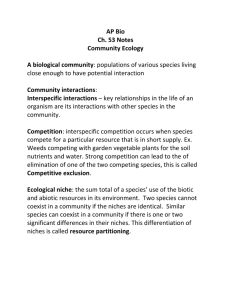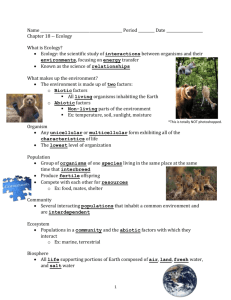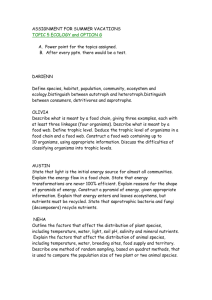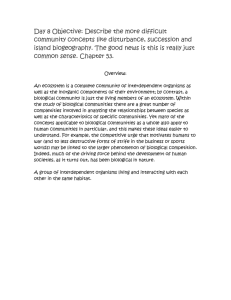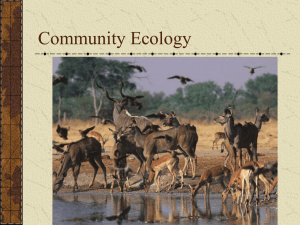BIOLOGY AP, September 12, 2003 - mvhs
advertisement
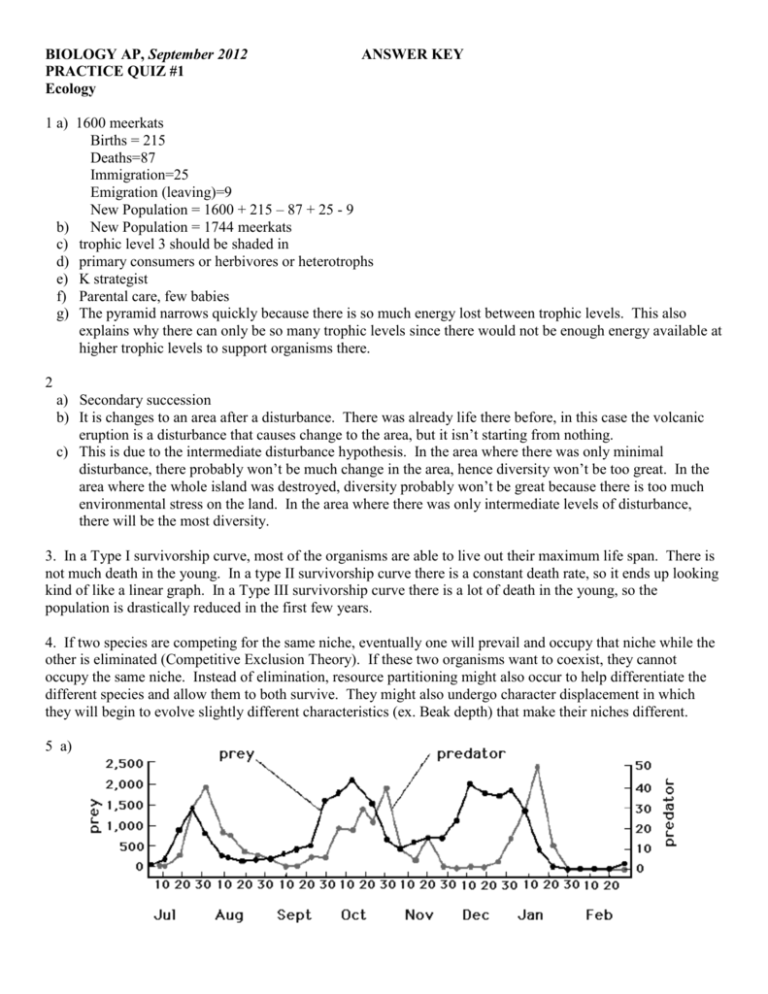
BIOLOGY AP, September 2012 PRACTICE QUIZ #1 Ecology ANSWER KEY 1 a) 1600 meerkats Births = 215 Deaths=87 Immigration=25 Emigration (leaving)=9 New Population = 1600 + 215 – 87 + 25 - 9 b) New Population = 1744 meerkats c) trophic level 3 should be shaded in d) primary consumers or herbivores or heterotrophs e) K strategist f) Parental care, few babies g) The pyramid narrows quickly because there is so much energy lost between trophic levels. This also explains why there can only be so many trophic levels since there would not be enough energy available at higher trophic levels to support organisms there. 2 a) Secondary succession b) It is changes to an area after a disturbance. There was already life there before, in this case the volcanic eruption is a disturbance that causes change to the area, but it isn’t starting from nothing. c) This is due to the intermediate disturbance hypothesis. In the area where there was only minimal disturbance, there probably won’t be much change in the area, hence diversity won’t be too great. In the area where the whole island was destroyed, diversity probably won’t be great because there is too much environmental stress on the land. In the area where there was only intermediate levels of disturbance, there will be the most diversity. 3. In a Type I survivorship curve, most of the organisms are able to live out their maximum life span. There is not much death in the young. In a type II survivorship curve there is a constant death rate, so it ends up looking kind of like a linear graph. In a Type III survivorship curve there is a lot of death in the young, so the population is drastically reduced in the first few years. 4. If two species are competing for the same niche, eventually one will prevail and occupy that niche while the other is eliminated (Competitive Exclusion Theory). If these two organisms want to coexist, they cannot occupy the same niche. Instead of elimination, resource partitioning might also occur to help differentiate the different species and allow them to both survive. They might also undergo character displacement in which they will begin to evolve slightly different characteristics (ex. Beak depth) that make their niches different. 5 a) b) Density Dependent Factor c) Density Independent Factor 6 a) Commensalism b) Mutualism c) Commensalism 7 a) An example of aposematic coloring would be a skunk’s white stripe. b) An example of Batesian mimicry is when the hawkmoth larva pretends to be a parrot snake c) An example of cryptic coloration would be the stickbug 8. Gross Primary Productivity is how much light energy has been converted into chemical energy by plants and other photosynthetic organisms. Net Primary Productivity is when you take the Gross Primary Productivity and subtract the energy the plants and other photosynthetic organisms require for their own cellular respiration. 9a) (500/100)*(500) = 2500 b) Births =(2500/2)*20 = 25000 Deaths=500 Immigration=0 Emigration (leaving)=100 New Population = 2500 + 25000 - 500 + 0 - 100 New Population = 26900 c) Various factors will prevent this population from unlimited growth. These include: lack of food resources, predators (including human intervention), disease amongst the rats, and lack of space/shelter. 11) Heterotrophs SECONDARY CONSUMERS AUTOTROPHS 12. Because mammals must use energy to regulate their body temperature, we may predict that fish are more efficent at passing on energy to the next trophic level. 13. In an unstable environment, r-selection might be more predominant. K-selection relies on constant care of an organism, and in an unstable environment, this may be more difficult. r-selection might distribute organisms at a wider scale and thus have a higher chance that one might survive the harsh, unpredictable conditions. 14. a) Keystone species b) Based on the fact that the loss of the Pisaster sea star impacted many of the other species in the area, it seems to exert a strong influence over the other species in the ecosystem. There is no indication that it is the most abundant (which would be the definition of a dominant species) c) If the Pisaster are removed, the mussel population would most likely increase in number since there would be fewer predators. d) Abiotic factors include: wind, temperature, salt content of the water Biotic factors include: all of the organisms in the area as well as the interactions between them (such as predation, parasites, disease, as well as other symbiotic interactions (like commensalism or mutualism)


